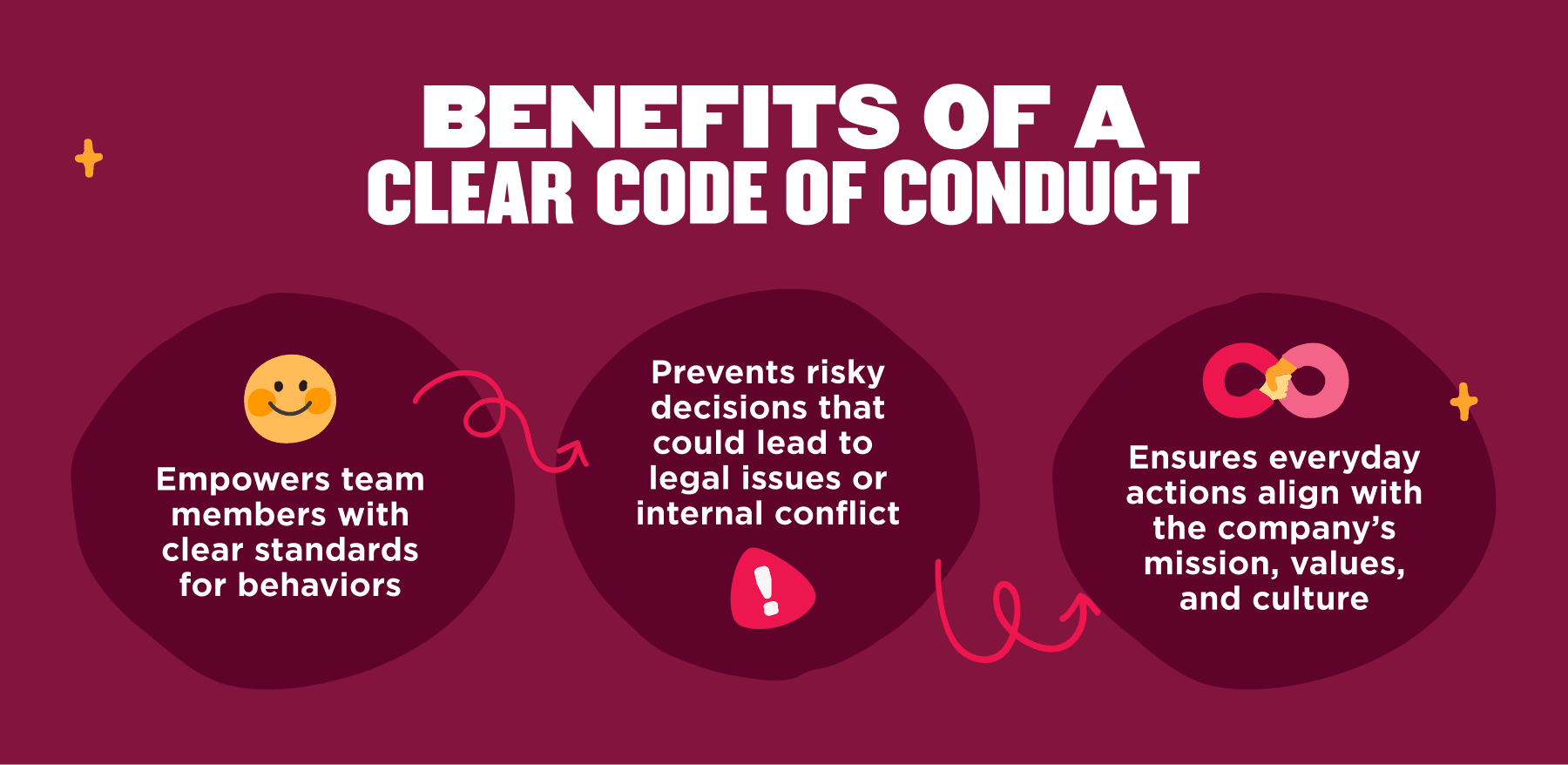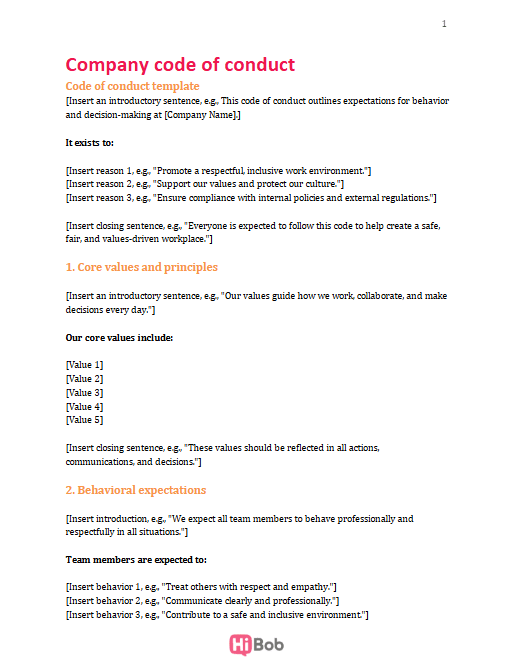A company code of conduct is a formal document that explains acceptable workplace behavior and practices to ensure employee alignment with company values and culture.
As businesses grow and teams become more diverse and distributed, having a clear code of conduct becomes essential. It sets the tone for workplace behavior, reinforces your company’s core values, and signals what your company stands for. More than a document, it’s a reflection of your culture—and a tool for building trust, consistency, and accountability from day one.
<<Use this company code of conduct template to put your people first.>>
What is a code of conduct for a company?
A company code of conduct is a roadmap for building a workplace grounded in integrity and respect. It sets expectations for behaviors and practices that reflect organizational values, covering areas such as ethics, fair employment, workplace safety, anti-harassment, wellbeing, disciplinary actions, and confidentiality for those who raise concerns. HR leaders play a central role in shaping these documents so they align with company goals, protect reputation, and foster a culture where people feel supported to do their best work.
Code of conduct vs code of ethics
While a code of conduct outlines specific behaviors and rules team members are expected to follow—often in relation to compliance, workplace etiquette, or legal obligations—a code of ethics focuses on the underlying principles and values that guide decision-making across the organization.
It addresses the “why” behind the “what,” helping teams align their actions with the company’s purpose, culture, and moral framework. It empowers people to make thoughtful choices in complex or ambiguous situations, even when there’s no written rule to follow.

Why should HR leaders care about a company code of conduct?
A code of conduct isn’t just a compliance document. It’s a foundational tool that protects your people, your culture, and your company’s reputation. Without clear, easy-to-follow guidelines, even well-meaning professionals can make decisions that put the organization at risk.
Consider the recent case of Kohl’s. In 2025, the company’s board dismissed CEO Ashley Buchanan after determining he had violated policies around undisclosed conflicts of interest. According to Kohl’s, the issue was unrelated to company performance, financial reporting, or operations, and it did not involve any other personnel. Even so, the breach of trust led to a leadership turnover and public scrutiny—demonstrating how critical it is to uphold clear ethical standards at every level of the business.
This high-profile example highlights an important truth: Ethical missteps—regardless of intent—can have serious consequences. For HR leaders, it’s a reminder that a code of conduct isn’t just about rules. It’s about reinforcing the behaviors and principles that hold your organization together, from the C-suite to individual contributors.
A strong, accessible code of conduct helps HR leaders:
- Empower team members with clear standards for respectful, ethical behavior
- Prevent risky decisions that could lead to legal issues, public scrutiny, or internal conflict
- Ensure everyday actions align with the company’s mission, values, and culture
Rather than reacting to issues after they happen, HR leaders can use codes of conduct to proactively shape a safe, transparent, and values-driven environment.
<<Get started with this free company code of conduct template.>>
Code of conduct examples
Here are how some major companies put their codes of conduct into action by defining expectations and strengthening them through policy and practice.
1. Dutch Bros Coffee
Dutch Bros Coffee’s Code of Business Conduct and Ethics applies to all employees, officers, and directors.. It prohibits insider trading and requires anyone with access to nonpublic information not to use or share it for securities trading.
The code also demands compliance with anti-bribery and antitrust laws globally, and it flags that even the appearance of a conflict of interest should be avoided, such as holding financial interests in competitors, customers, or suppliers. Dutch Bros treats violations seriously—consequences may include termination, legal referral, or civil action depending on severity.
2. L.L.Bean
L.L.Bean’s code of conduct has over 180 specific factory-level standards used by auditors when inspecting vendor operations. Their vendor requirements cover wages (must meet industry or legal minimums, whichever is higher), legally‐required benefits, and overtime compensation rates of at least 1.5x in places without strict overtime laws.
The code limits weekly working hours to 48 (except under extraordinary circumstances) and ensures workers get at least one day off per week. It also protects freedom of association (where permitted) and bans harassment, child labor, and forced labor in its supply chain.
3. Ben & Jerry’s
Ben & Jerry’s integrates its social mission deeply into its operational and sourcing practices. The company runs a “linked prosperity” model, meaning as the business prospers, its suppliers, communities, and co-workers benefit too. Their ingredients are Fairtrade Certified, and they support farmworker rights through programs like Milk with Dignity, which ensures standards for fair wages and safe working conditions at dairy farms.
Ben & Jerry’s also leads values-led hiring, removing barriers (like criminal history checkboxes) to give people second chances and reflect their inclusive mission in staffing. Co-workers are encouraged to embed their values in everyday decisions—on equity, climate, human rights—and the business actively participates in activism aligned with those values.
Recommended For Further Reading
4. Johnson & Johnson
Johnson & Johnson’s code of business conduct is tightly coupled with its long-standing “Our Credo,” which places the needs and wellbeing of patients, co-workers, communities, and shareholders at its center.
The code requires all team members to maintain integrity in areas like conflicts of interest, use of company assets, privacy, and quality of products. It also provides a confidential Integrity Line (available 24/7, in multiple languages) for reporting violations or concerns. Violations may lead to corrective actions, including termination. J&J also regularly updates the code to address changes in technology and regulation.
5. Gap Inc.
Gap Inc.’s Code of Business Conduct (COBC) applies to all employees, directors, and subsidiaries. It emphasizes that “how we do business is as important as what we do,” requiring adherence to integrity, legal compliance, and ethical decision-making in every market. The company also maintains a Global Integrity Committee, led by the chief compliance officer, to monitor code compliance, audit risks, and advise on enforcement actions.
Gap extends its ethical standards into its supply chain via its Code of Vendor Conduct (COVC), which aligns with International Labour Organization standards and demands that factory partners meet labor, anti-bribery, and environmental diligence requirements. Violations can lead to termination of supplier contracts or internal disciplinary action, reinforcing that ethical behavior is nonnegotiable across its operations.
6. Google
Google’s code is built around the idea that every decision should be measured against the highest standard of ethical business conduct. It emphasizes principles like respect for users, transparency, accountability, and encourages team members to speak up when they see something that doesn’t feel right.
The code covers broad responsibilities—from how Google team members represent themselves in public, to conflicts of interest or misuse of company property—and extends expectations to contractors and vendors working with Google. The end of the code reinforces their commitment to “Don’t be evil.”
Through this framework, Google seeks to maintain trust with users and stakeholders and anchor innovation to integrity, not just output.
7. Marriott
Marriott’s Business Conduct Guide applies broadly to all “associates,” which includes team members, officers, and anyone acting on behalf of Marriott globally. Through this guide, the company expects everyone to obey laws and uphold the company’s integrity standards.
It covers issues such as anti-bribery, fair competition, human trafficking, use of company assets, and vendor compliance. Associates and managers are required to certify their understanding of the guide and managers are expected to help their teams interpret and live out the policies. Marriott enforces non-retaliation protections for people who report violations and handles misconduct through consistent investigation and discipline.
8. Walmart
Walmart’s code emphasizes its four core values—respect, service, excellence, and integrity—which guide decisions at every level. The code applies to all associates and business partners and expects them to act with integrity in areas such as product safety, data usage, and compliance with legal and regulatory standards.
Walmart provides a 24/7 multilingual Ethics Helpline for reporting misconduct, and the company prohibits retaliation against those who report in good faith. Their compliance policies also include specific rules on supplier standards, insider trading, and global trade.
<<Build your own company code of conduct with this free template.>>
What to include in your company code of conduct
Creating an effective company code of conduct involves several key elements that ensure clarity and practicality. Here’s what to include:
- Introduction and purpose: Clearly state why the code exists and its importance to help everyone understand its relevance.
- Core values and principles: Outline your organization’s values and guiding principles. This provides a moral compass for behavior and decision-making.
- Behavioral expectations: Specify the conduct expected in various situations, including interactions with colleagues and clients. This section is crucial for maintaining professionalism.
- Compliance and legal obligations: Highlight the need to adhere to laws and regulations. This ensures everyone is aware of their legal responsibilities.
- Conflict of interest: Define conflicts of interest and how to manage them. This helps maintain transparency and fairness across the board.
- Confidentiality and data protection: Emphasize the importance of safeguarding sensitive information.
- Reporting violations: Provide a straightforward process for reporting breaches. This encourages accountability and protects whistleblowers.
- Consequences of violations: Clearly outline what happens if the code is not followed. This underscores the seriousness of compliance.
- Review and amendments: Explain how the code will be reviewed and updated. This keeps it relevant and effective over time.
- Acknowledgment and training: Require acknowledgment of the code and regular training to encourage commitment and ensure everyone is on the same page.
Company code of conduct template
[Insert an introductory sentence, e.g., This code of conduct outlines expectations for behavior and decision-making at [Company Name].]
It exists to:
- [Insert reason 1, e.g., “Promote a respectful, inclusive work environment.”]
- [Insert reason 2, e.g., “Support our values and protect our culture.”]
- [Insert reason 3, e.g., “Ensure compliance with internal policies and external regulations.”]
[Insert closing sentence, e.g., “Everyone is expected to follow this code to help create a safe, fair, and values-driven workplace.”]
1. Core values and principles
[Insert an introductory sentence, e.g., “Our values guide how we work, collaborate, and make decisions every day.”]
Our core values include:
[Value 1]
[Value 2]
[Value 3]
[Value 4]
[Value 5]
[Insert closing sentence, e.g., “These values should be reflected in all actions, communications, and decisions.”]
2. Behavioral expectations
[Insert introduction, e.g., “We expect all team members to behave professionally and respectfully in all situations.”]
Team members are expected to:
- [Insert behavior 1, e.g., “Treat others with respect and empathy.”]
- [Insert behavior 2, e.g., “Communicate clearly and professionally.”]
- [Insert behavior 3, e.g., “Contribute to a safe and inclusive environment.”]
- [Insert behavior 4, e.g., “Act with honesty and integrity in all business dealings.”]
Prohibited behaviors include:
- [Insert prohibited behavior 1]
- [Insert prohibited behavior 2]
Relevant policy: [Link to anti-harassment or conduct policy, if applicable]
3. Compliance and legal obligations
[Insert an introduction, e.g., “All team members are responsible for complying with applicable laws, regulations, and internal policies.”]
This includes:
- [Insert legal requirement 1, e.g., “Employment laws in your jurisdiction.”]
- [Insert legal requirement 2, e.g., “Data protection and privacy regulations.”]
- [Insert legal requirement 3, e.g., “Anti-bribery and anti-corruption laws.”]
[Insert statement, e.g., “Violations may result in disciplinary action or legal consequences.”]
4. Conflicts of interest
[Insert introduction, e.g., “A conflict of interest arises when personal interests interfere with professional responsibilities. These situations should be avoided or disclosed.”]
Team members should:
- [Insert guideline 1, e.g., “Disclose any outside roles or investments.”]
- [Insert guideline 2, e.g., “Avoid influencing decisions that involve family or friends.”]
- [Insert guideline 3, e.g., “Seek approval before accepting gifts from vendors or partners.”]
Conflicts must be reported to: [Insert role/contact person]
5. Confidentiality and data protection
[Insert introduction, e.g., “Protecting company and customer data is a shared responsibility. All team members must handle information with care.”]
Team members must:
- [Insert requirement 1, e.g., “Keep customer and company data secure.”]
- [Insert requirement 2, e.g., “Follow all cybersecurity protocols.”]
- [Insert requirement 3, e.g., “Never share confidential information externally without approval.”]
Related policy: [Insert link or reference]
6. Reporting violations
[Insert introduction, e.g., “We encourage team members to report concerns openly and without fear of retaliation.”]
You can report issues through:
- [Insert reporting channel 1]
- [Insert reporting channel 2]
- [Insert anonymous option, if available]
We commit to:
- [Insert commitment 1, e.g., “Investigate all concerns fairly and promptly.”]
- [Insert commitment 2, e.g., “Protect against retaliation for good-faith reports.”]
7. Consequences of violations
[Insert introduction, e.g., “Violating this code may result in disciplinary action, depending on the severity and nature of the breach.”]
Consequences may include:
- [Insert example consequence 1, e.g., “Formal warning or coaching.”]
- [Insert example consequence 2, e.g., “Suspension or termination.”]
- [Insert example consequence 3, e.g., “Legal action, if applicable.”]
8. Review and amendments
[Insert statement, e.g., “This code will be reviewed regularly to ensure it reflects our evolving culture, policies, and legal requirements.”]
Review frequency: [Insert how often, e.g., “Annually” or “Every 18 months”]
Responsible team or person: [Insert responsible party]
[Insert statement, e.g., “Team members will be informed of any significant changes or updates.”]
9. Acknowledgment and training
[Insert statement, e.g., “All team members must acknowledge this code and participate in training to ensure shared understanding and accountability.”]
All team members are expected to:
- [insert condition, e.g., “Review and acknowledge this code during onboarding.”]
- [insert condition, e.g., “Participate in ongoing training related to conduct and compliance.”]
- [insert condition, e.g., “Seek clarification when unsure about the expectations outlined here.”]
Acknowledgment
[Insert final acknowledgment statement, e.g., “I confirm that I have read, understood, and agree to follow the [Company Name] Code of Conduct.”]
Name: ______________________________
Signature: ___________________________
Date: _______________________________
Optional: Additional linked policies or documents
You may include the following as appendices or links:
- Anti-harassment policy
- DEI guidelines
- IT and cybersecurity policy
- Social media guidelines
- Reporting or escalation procedure
<<Download this free code of conduct template to support your HR initiatives.>>
What can HR leaders do to ensure compliance with a company code of conduct?
While developing an up-to-date and fair company code of conduct is crucial, it’s equally important to enforce it. HR leaders can implement these practical steps to encourage people to adhere to the code:
- Collaborate: HR leaders can cooperate with team members to develop the company code of conduct. Involving your people in this initiative empowers them and instills a feeling of collective responsibility.
- Educate: HR professionals can frequently educate people and managers on the different aspects of the code of conduct during training sessions and discussion groups. This helps encourage a thorough understanding of the organization’s behavioral standards and accepted practices.
- Infuse: To ensure that team members and managers internalize the company practices, HR leaders can infuse the code into the company culture by including it in the onboarding process, company-wide newsletter, and manager training sessions.
- Train and coach managers: Managers and supervisors should understand that they are responsible for setting an example for people to follow the company code of conduct. If a team member needs to file a complaint, managers should consider it a priority, and carve out time to meet the person privately. This provides them with the knowledge that their managers are available and approachable.
- Apply the code to everyone: Team members of all levels need to follow the code of conduct. HR leaders can draft a code of conduct specifically designed for managers, to equip them with the skills and tools to build a positive, safe, and healthy work environment.
Key takeaways
- A company code of conduct is a vital document that outlines acceptable behaviors and practices, ensuring alignment with company values and culture
- Key elements often included are ethics, fair employment, and confidentiality
- HR leaders play a crucial role in developing, communicating, and enforcing the code, collaborating with people to create a sense of shared responsibility
- Compliance with the code of conduct bolsters a positive work environment, encouraging safety, fairness, and motivation among team members
How can a code of conduct improve company culture?
A concise, simple, and comprehensive code of conduct functions as a company backbone, promoting upright conduct and acceptable behavior among people of all tiers. It encourages physical and mental safety, fairness, and equality. Team members who are valued by employers will feel more motivated to work at a high-performance level and contribute positive energy to build a healthy and wholesome company culture.
Company code of conduct FAQs
Why is a code of conduct important for my business?
A code of conduct is your roadmap for setting expectations. It provides clear guidelines that help everyone understand what’s acceptable. This alignment not only protects your company’s reputation but also creates a consistent and positive work environment.
How often do I need to review and update my company’s code of conduct?
You’ll want to review and update your code of conduct annually or whenever there are significant changes in your organization. Regular updates ensure that it remains relevant and reflects any new regulations or shifts in your company culture.
What happens if a team member violates the company code of conduct?
When a team member violates the code, address the situation promptly. Conduct a thorough investigation to understand the context, then apply appropriate disciplinary actions. This could range from a warning to termination, depending on the severity. Consistent enforcement is key to maintaining trust and integrity.

